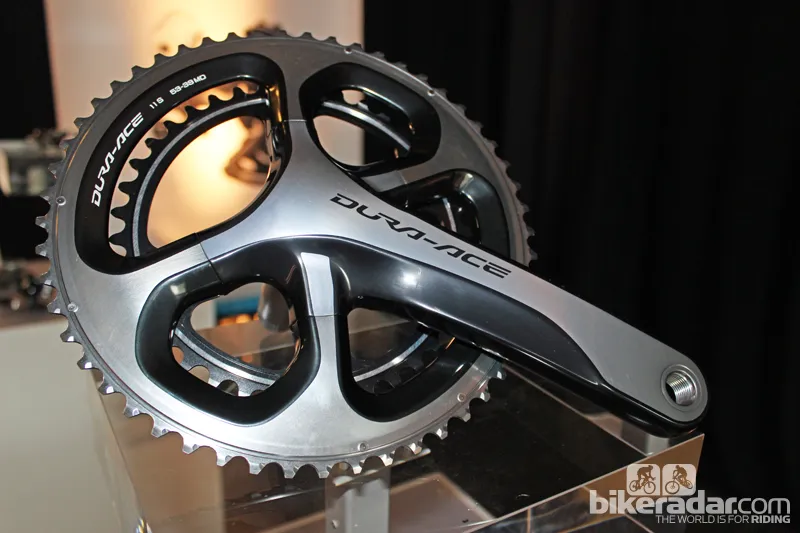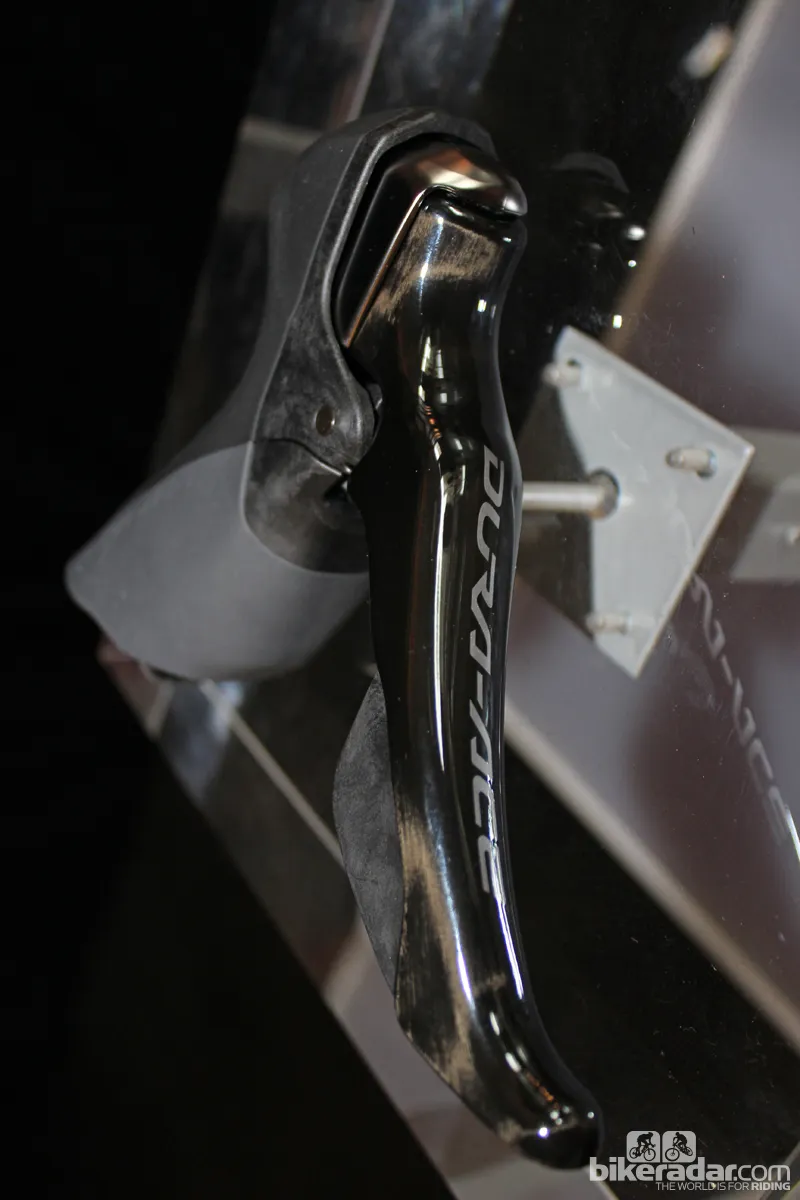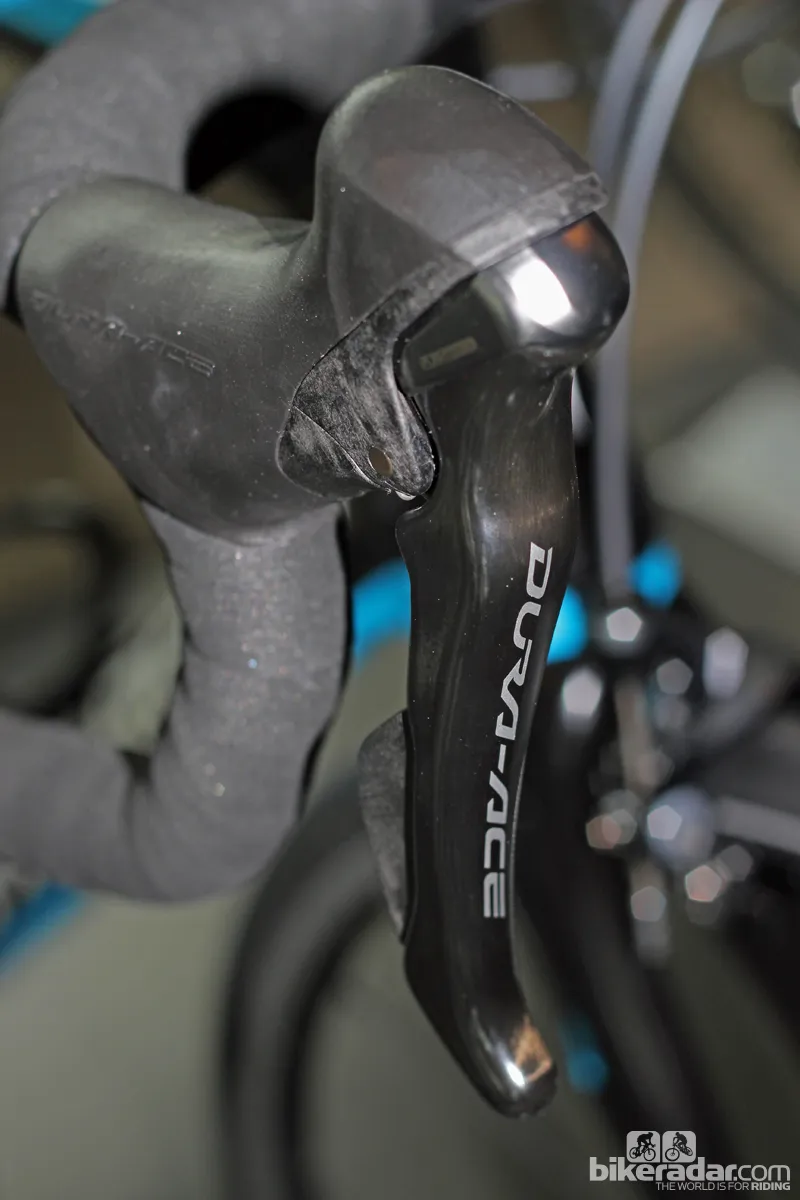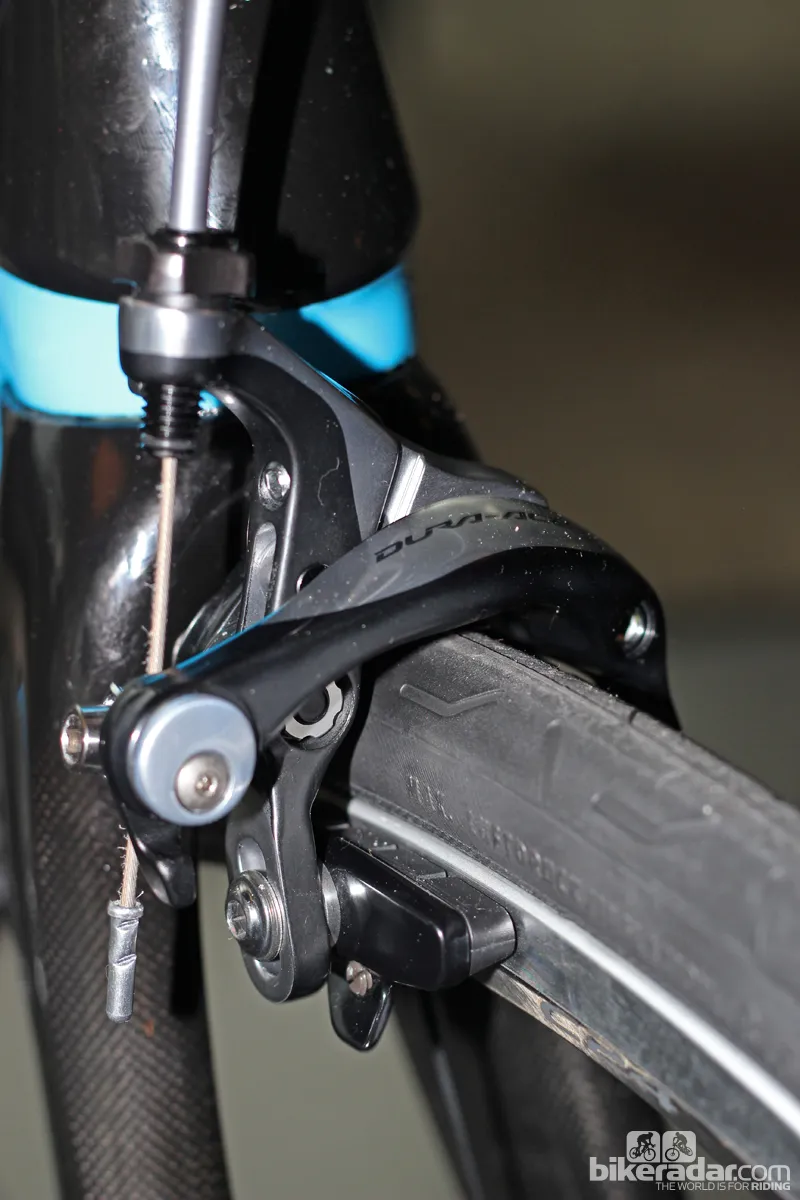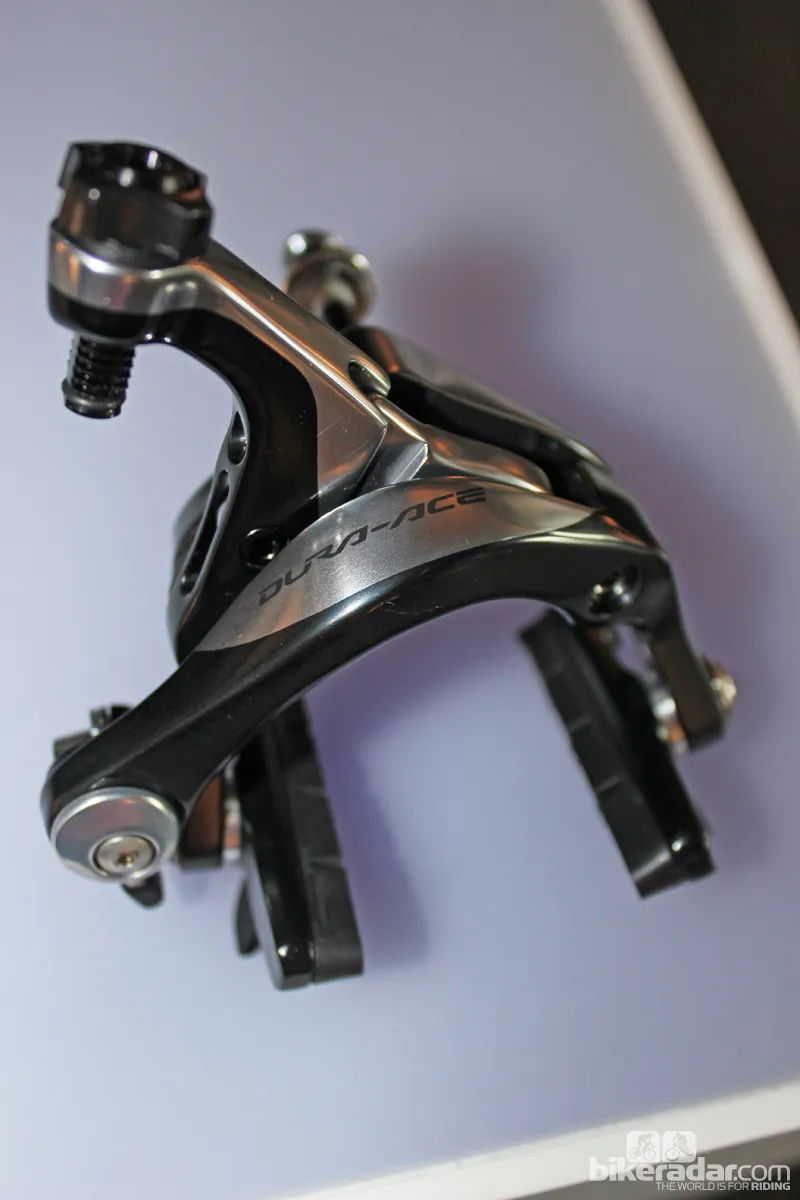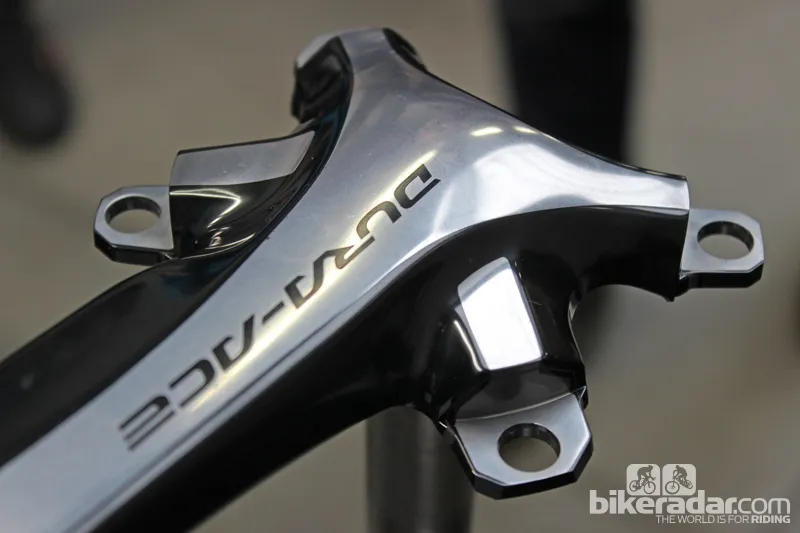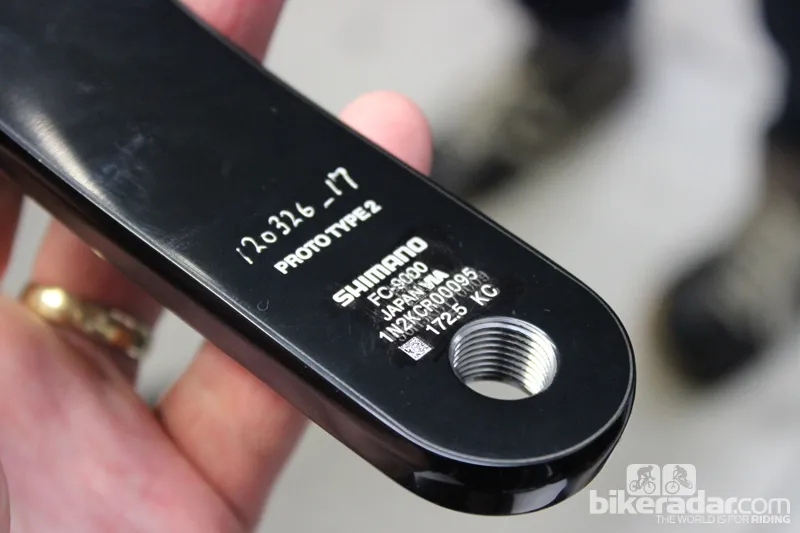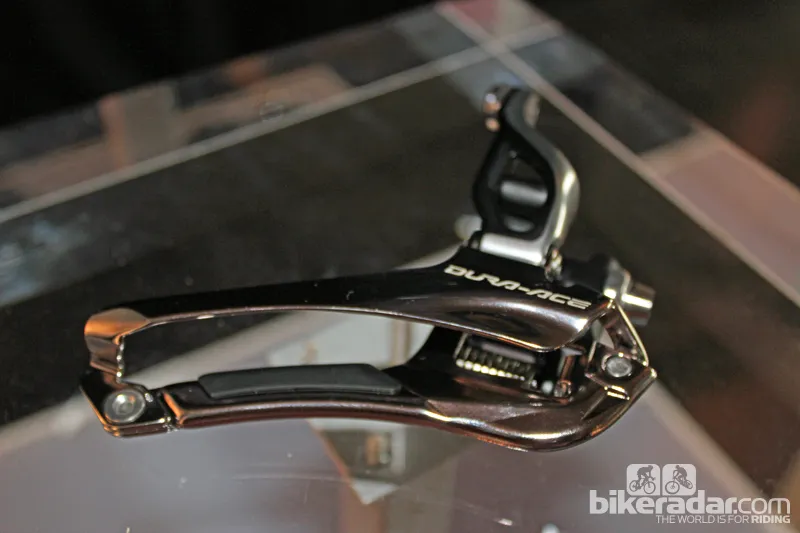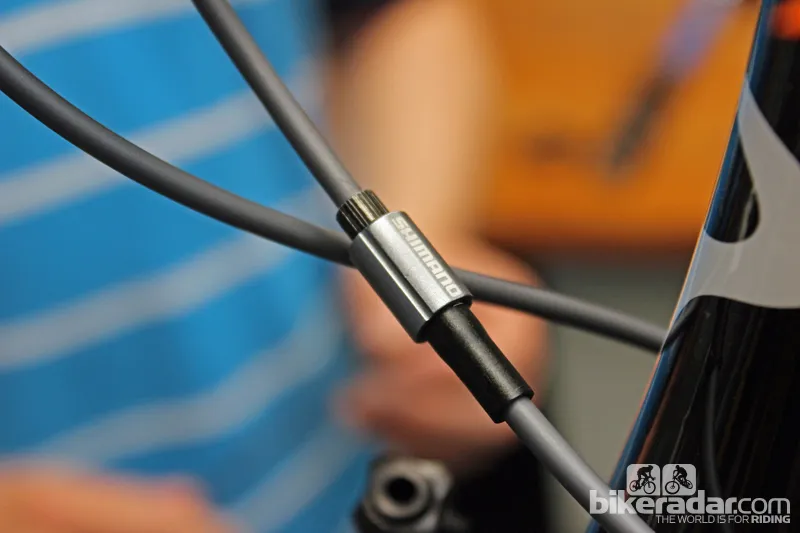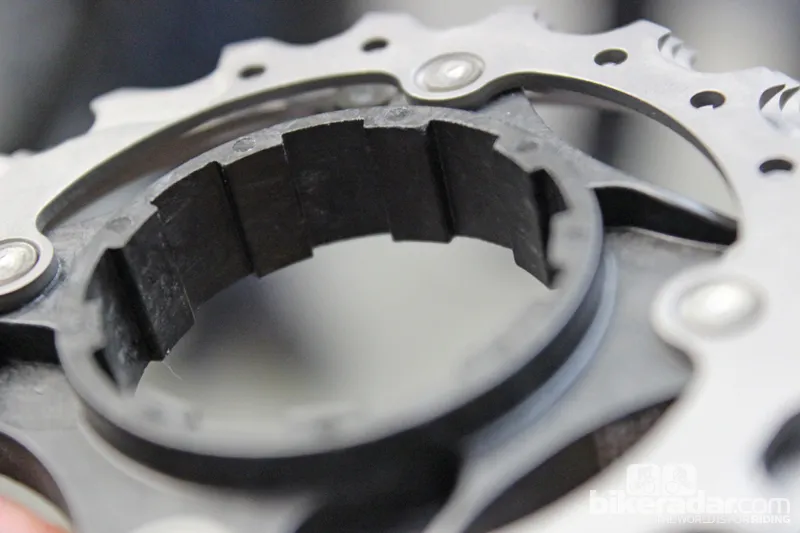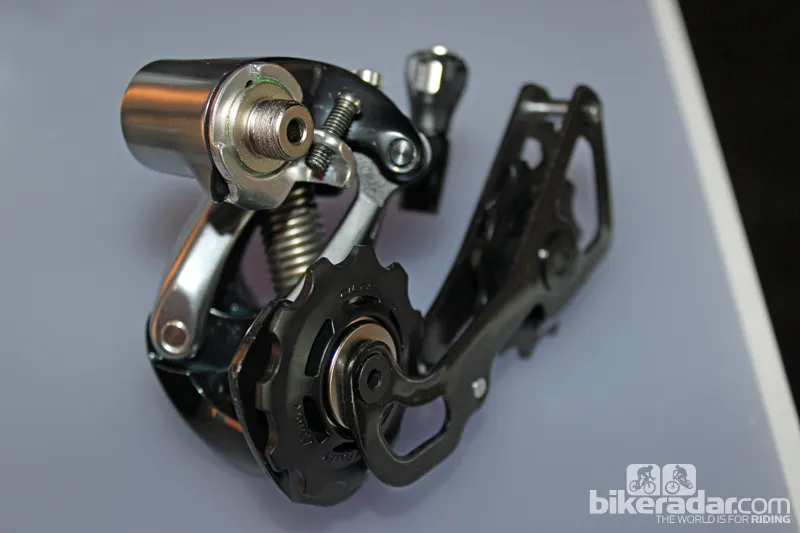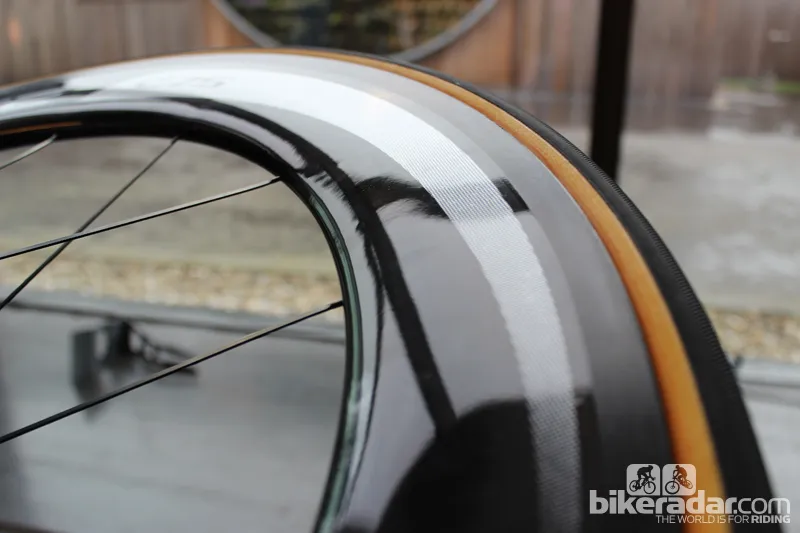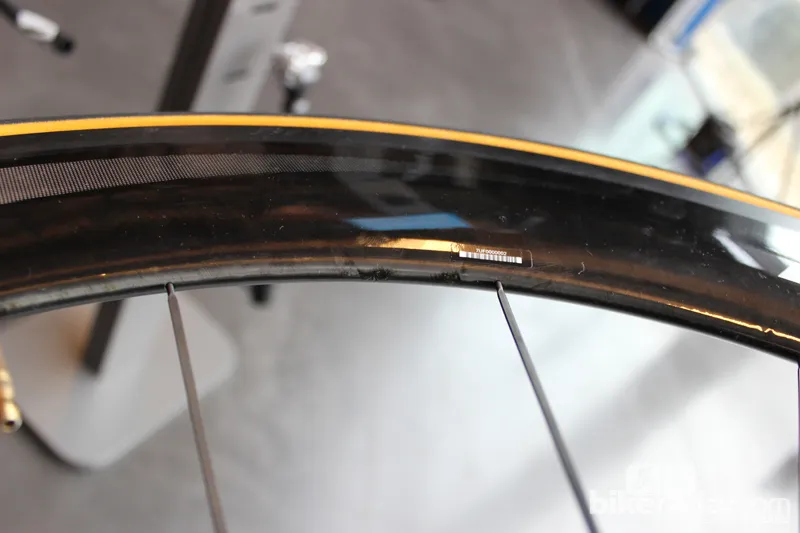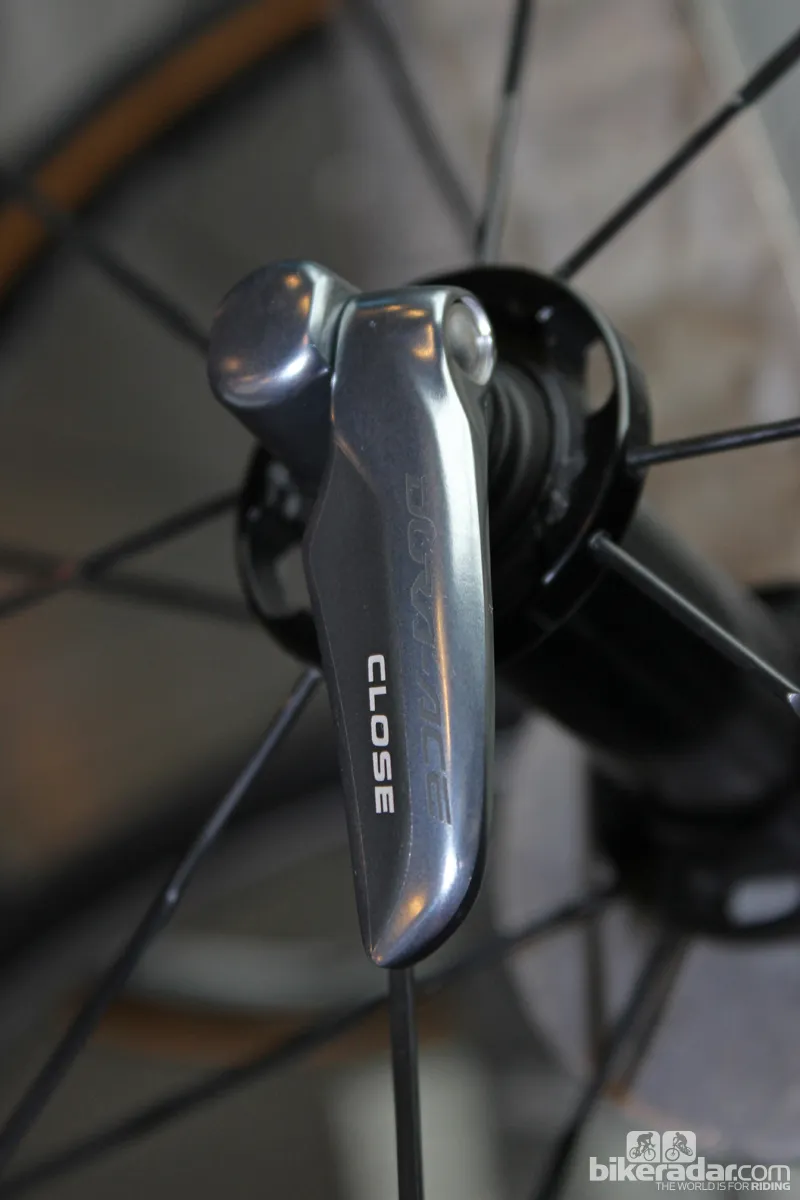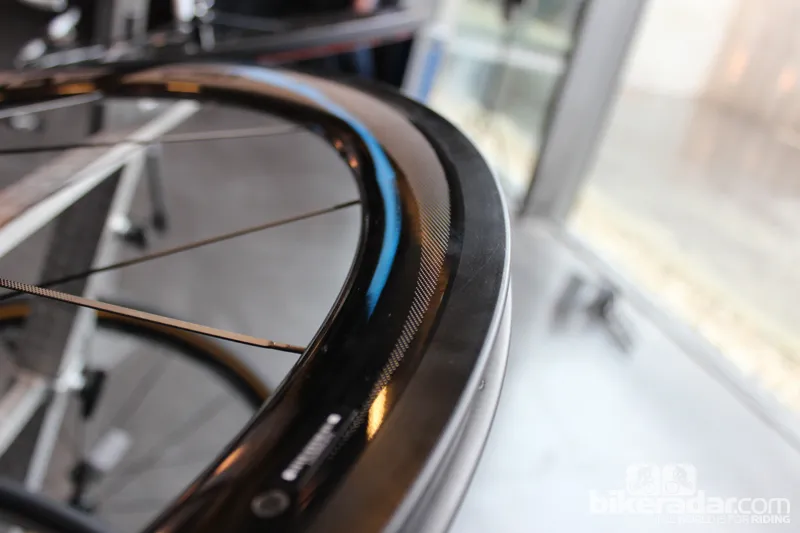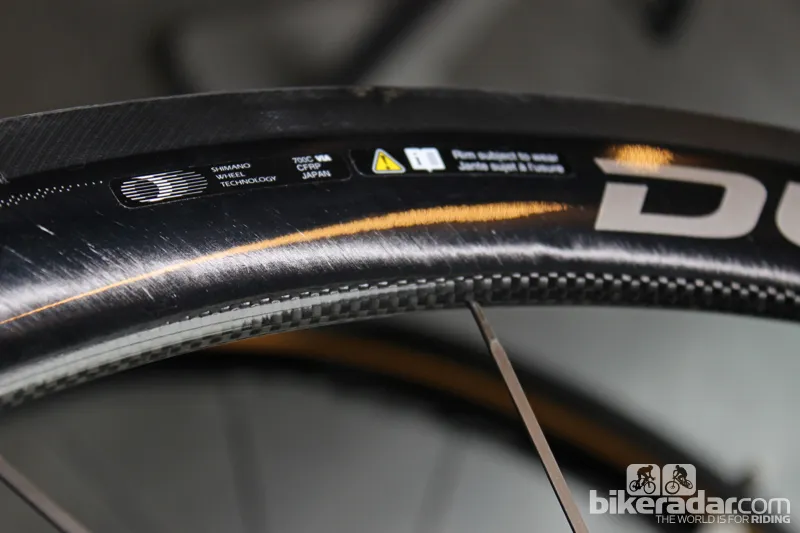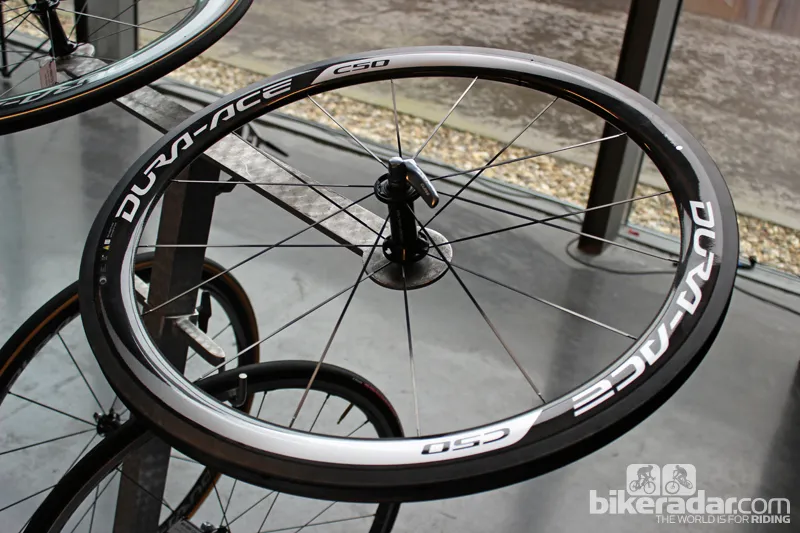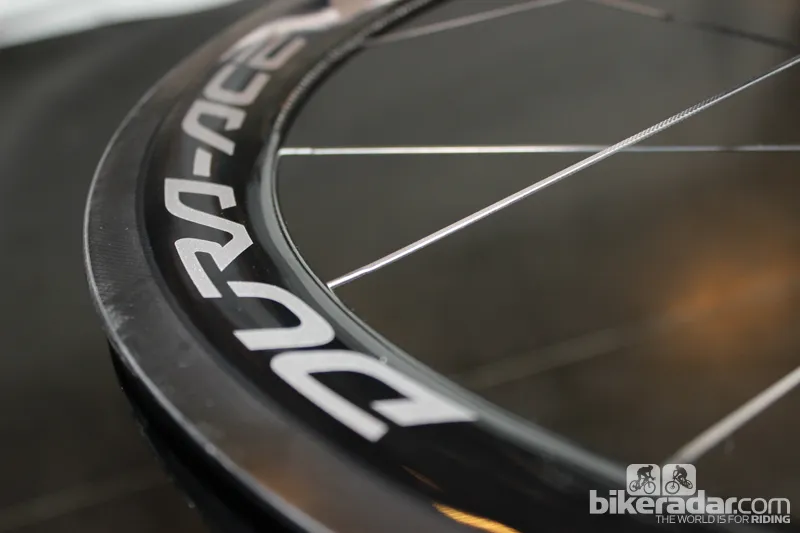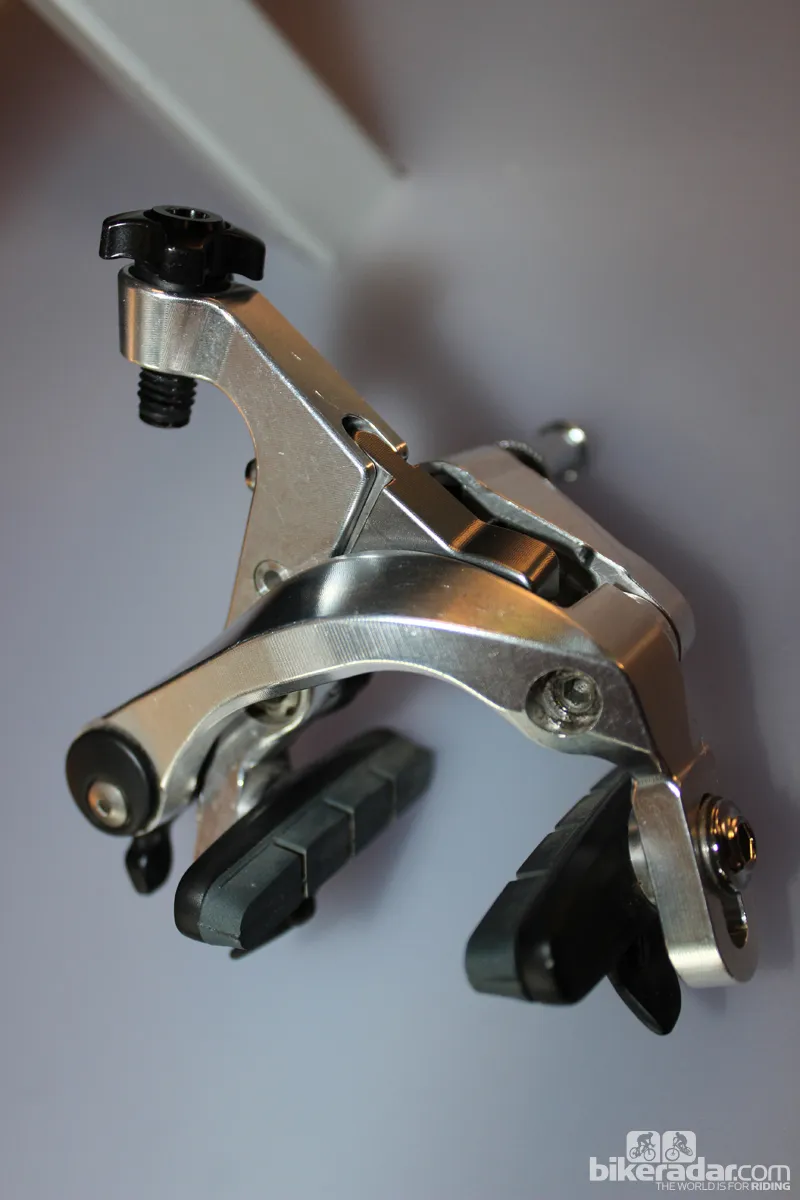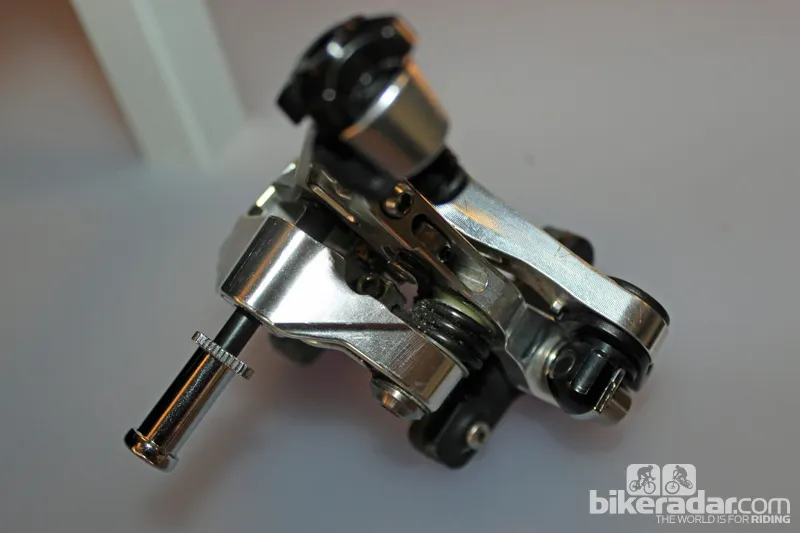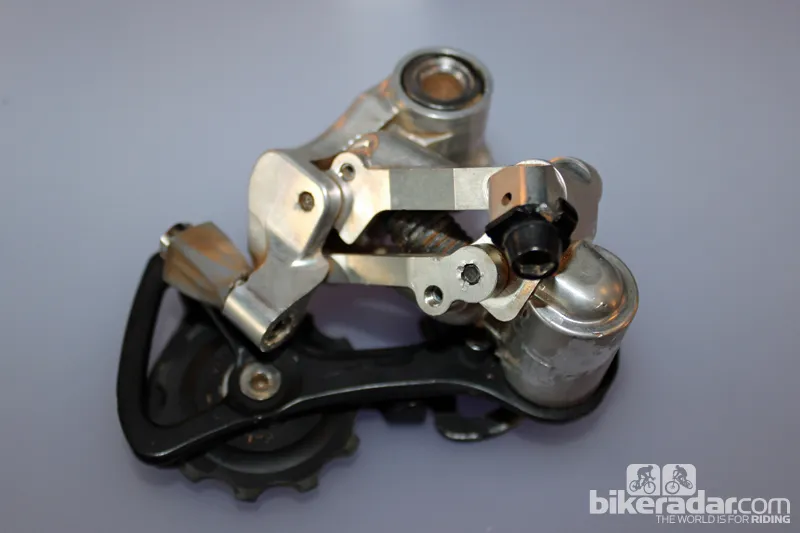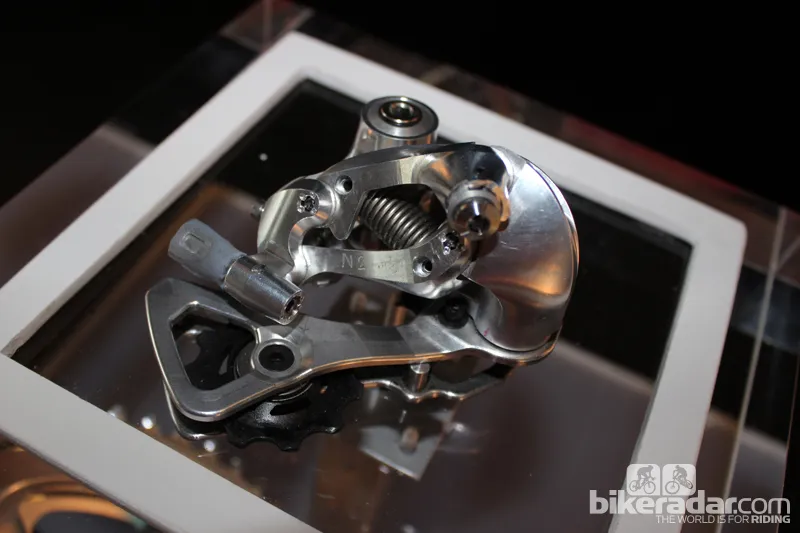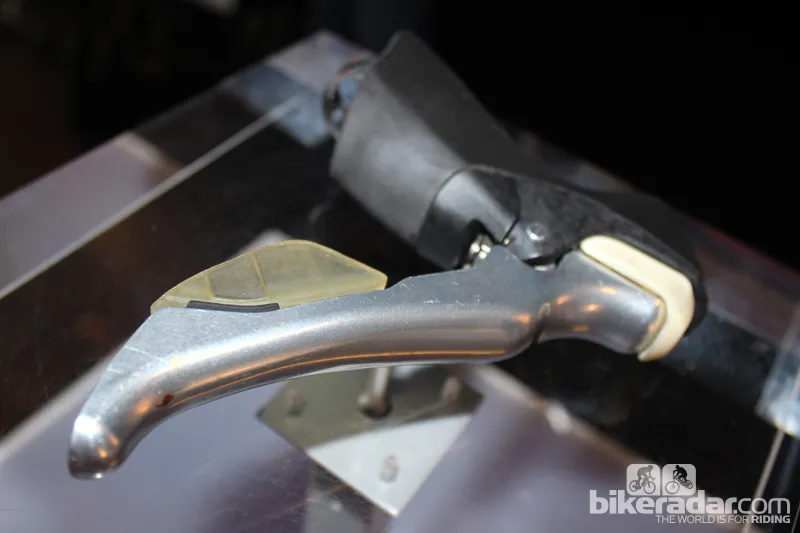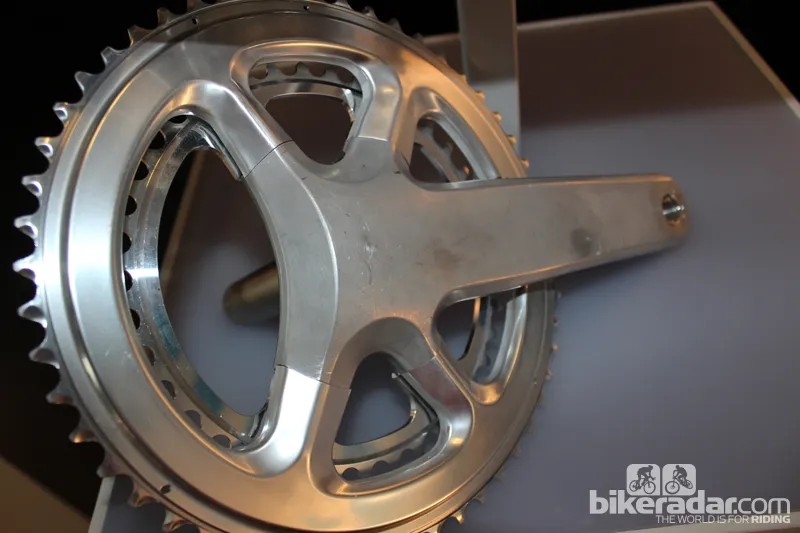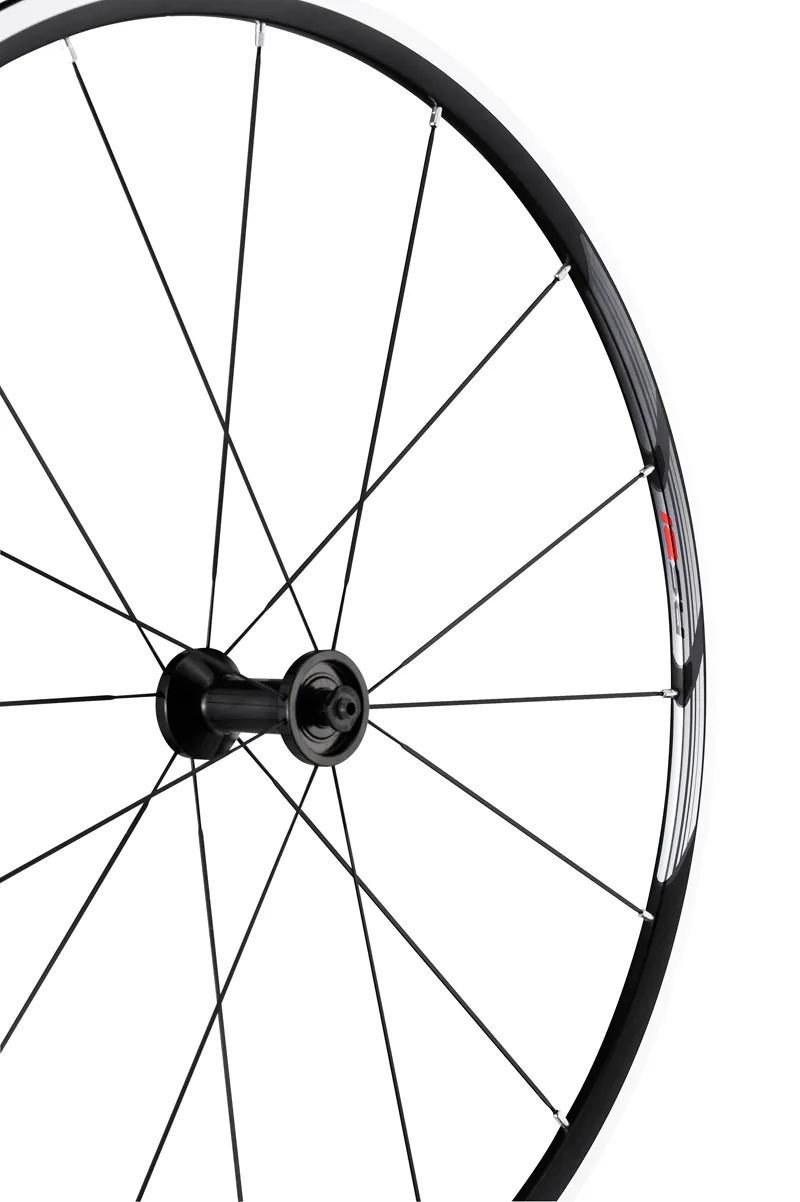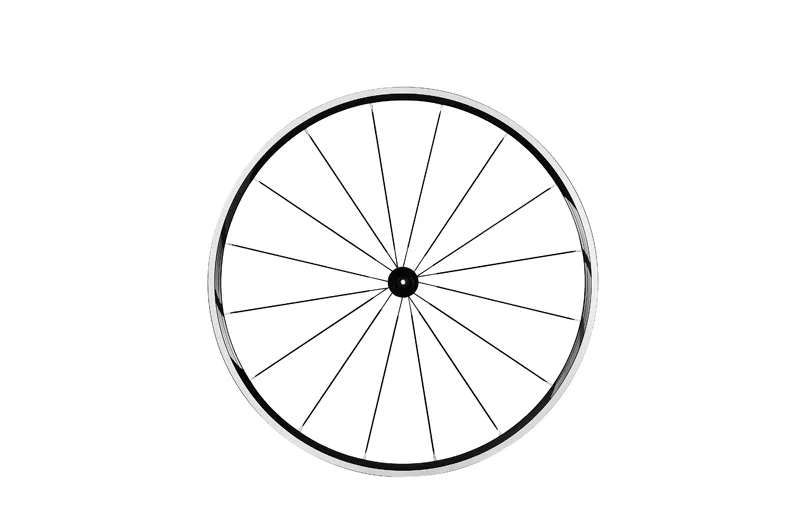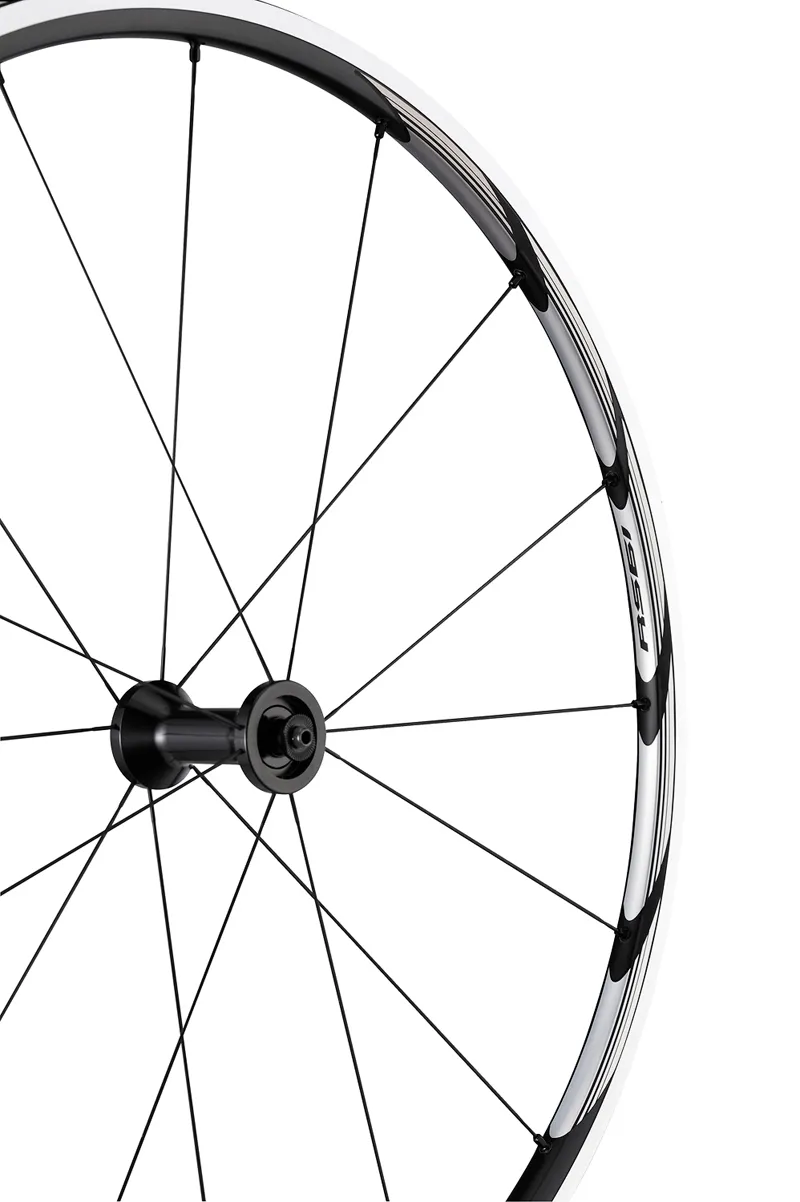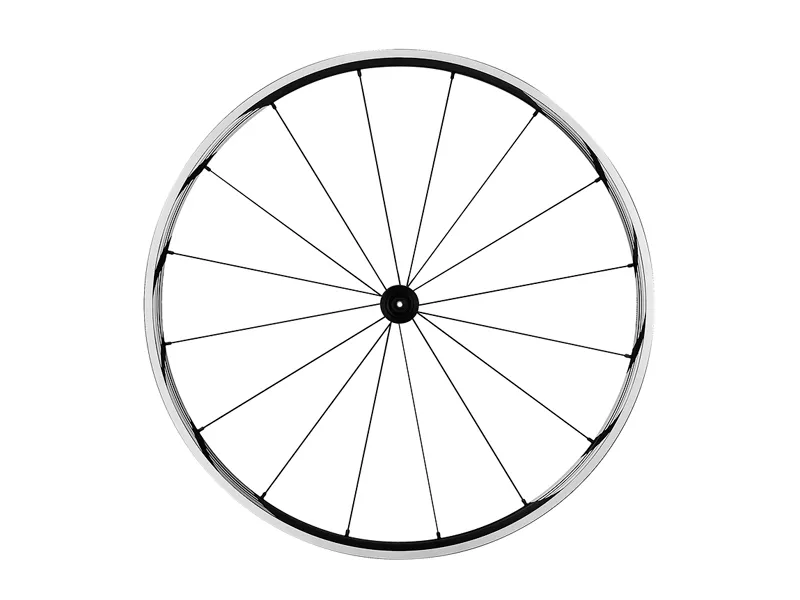See also BikeRadar's Shimano Dura-Ace 9000 group review.
It's been a busy year for Shimano with the launch of new entry-level road Sora and Tourney groupsets and electronic Alfine hub gearing, not to mention three new mountain bike groups – but it looks like they may have left the best till last. Officially unveiled today is a new 11-speed version of their flagship Dura-Ace road groupset
Shimano have given their top mechanical group a ground-up reworking for 2013, not just an extra sprocket on the cassette. We had the chance to try it out for ourselves at Team Sky’s European service course base in Kortrijk, Belgium with team riders Alex Dowsett and Michael Barry, who were both instrumental in the development of the new group.
Dura-Ace 9000 has already been used in competition at the Tour of Romandie, in its raw finish prototype stage. We were allowed to ride prototype revision two – as close to the final product as it gets, with only the hood covers and small cosmetic details to be refined.
Unable to load media
Shimano Dura-Ace (courtesy: Shimano)
Headline stats
Shimano's stated aim with the new Dura-Ace was to make it "more stylish, with better ergonomics, better shifting, better braking and easier setup". To achieve this, they've re-engineered every component. While weight wasn't the main focus of the redesign, Dura-Ace 9000 comes in 90g lighter, too, at 1,965g, compared to 2,055g for Dura-Ace 7900.
Tim Gerrets, Shimano’s European product manager, explained the goals of the new group. “We aimed to make the shifting feel more precise and improve the braking in both terms of out-and-out power and modulation and feel, especially when riding on the hoods," he said. "Professionals are comfortable riding in the drops constantly but committed sport riders tend to spend most of their time on the hoods so our ergonomics need to be optimised for this too."
Shimano are never short on buzzwords so expect to hear plenty of mentions of ‘Vivid’ shifting and ‘control-confidence-concentration’ when the group finally arrives in shops.
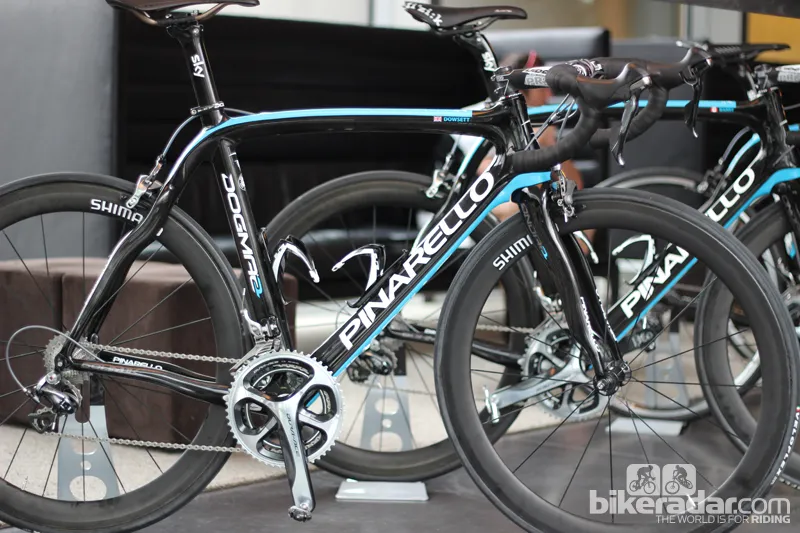
Team Sky’s Alex Dowsett has been running the new 11-speed Dura-Ace on his Pinarello Dogma2 all season
All-new shifters
The new shifter body emulates the shape of the Dura-Ace Di2 hood and is smaller in diameter than the outgoing mechanical shifter. Shimano claim this makes for a more comfortable grip from the hoods, which are made from a new dual compound rubber.
The brake lever blade has a new scalloped curve and prominent ridge. We found this offered more feel from the drops than before, and a much more positive feel from the hoods. Being able to control and feed-in braking with the smallest of inputs takes a little adjustment but we came away mightily impressed with just how much this element had improved.

The new brake lever shape has a more friendly feel from the hoods
Gear shifting is where the ST-9000 really scores, though. If we're honest, the last generation of Dura-Ace just didn’t live up to the name. The light action of the shift was good but sluggish front derailleur performance and a woolly feel just didn’t cut it for us. Shimano’s engineers explained that they wanted to retain the lightness of Dura-Ace 7900 (check) but revisit the snappy shift performance of the 7800 series.
To achieve this they've reduced the lever stroke of both the shifters and mechs. The result, according to Shimano, is that the large lever now shifts 47 percent quicker. By simplifying the cable routing through the body they've managed to decrease friction here by 20 percent, too. And you can add to that a claimed 30 percent reduction in the effort required to ship the chain across the sprockets.
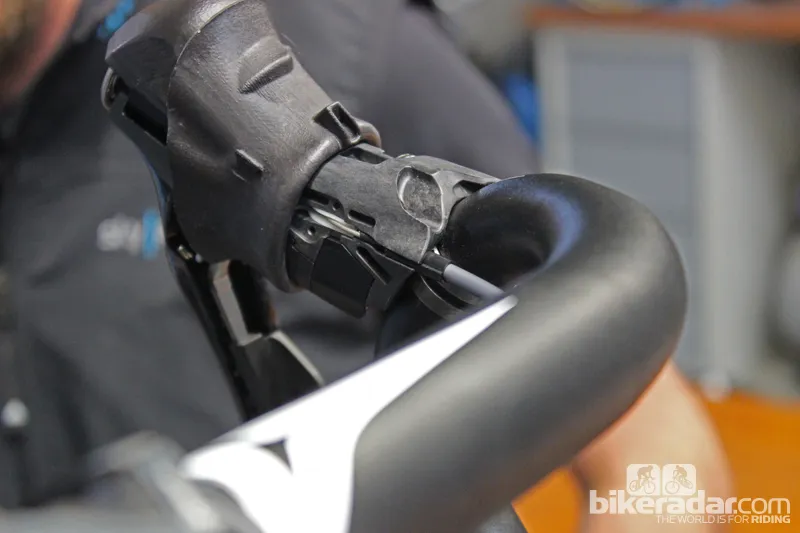
Routing in the shifter body has been simplified to reduce friction
Out on the road the new 9000 series felt like an old friend. It's incredibly light to get things moving, and the reduced lever sweep is welcome too, especially when trying to skip across gears when stomping over Belgian pave at 25mph . What really impressed, though, was the positive feel of the shifts, with a defined mechanical click as the chain drops into place. Dura-Ace now feeds back just the right right amount of info to let you know that it's moving across the block efficiently.
Front derailleur changes
The front mech uses a different cable pull ratio to before, and has a radical new shape, with a taller profile to increase leverage. Unlike the new SRAM Red front mech, Shimano have retained the trim ability, though it now works in the reverse of previous models.
The mech shifts out and has a further trim setting outside of the normal range. This means more care is required when setting up (and by 'care' we mean reading the instructions) but the drivetrain will more readily accept angled chainlines. We happily ran a 53/25-tooth combination over the pave with no chain rub noise and without dropping the chain when quickly skipping through the sprockets in either ring.
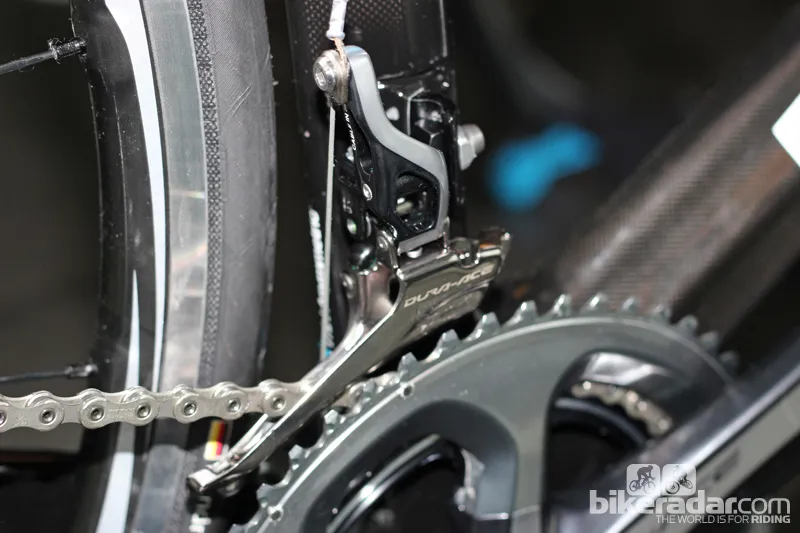
The new front mech has a longer pivot, creating a lighter and shorter shifting action
True dual-pivot brakes
The biggest change to Dura-Ace, and perhaps the most needed, is to the brakes. Out goes Shimano’s long-standing dual-pivot design, where the mounting bolt doubles as the second pivot for the brake arms. In comes a new design that relies on two parallel pivots that sit either side of the brake body, with the mounting bolt on a plate affixed to the back.
The pivoting arms give a more equal pull – those of you familiar with the classic U-brake design will see some similarities. Top-end power and braking feel are improved by use of a clever roller cam and the fact that the brake's pivots are now closer to the rim. Cable routing remains to the side, as with previous models, but the cam design means the left and right arms offer equal pull and power.
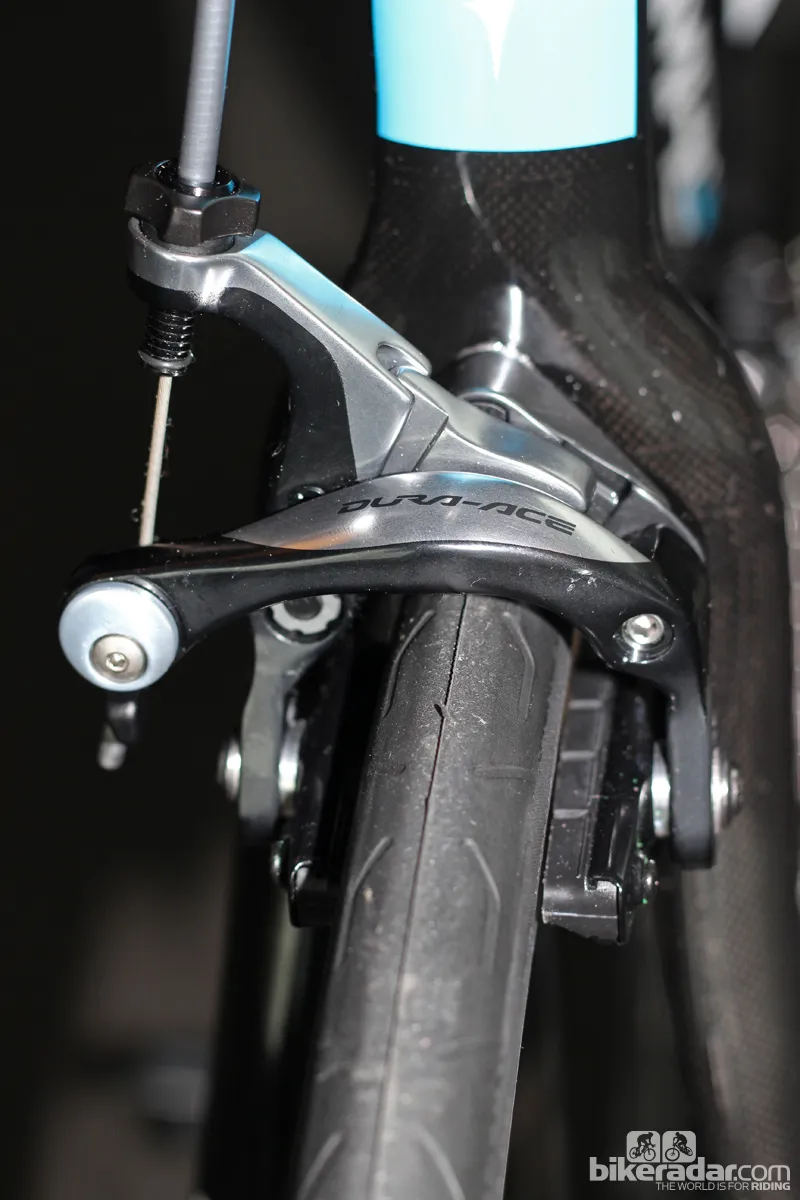
The new brake has a pivot on each side of the wheel, with the central bolt now only used for attachment purposes
The switch to a dual-pivot design has allowed Shimano to create a direct mount variant where the mounting bolt and plate are removed and replaced with mount bolts at each of the pivots. An aero-optimised version is on the way with a repositioned cable stop arm for time trial and triathlon bikes. Named BR-9010 its also loses the quick-release mechanism for a stealthier shape but will be shipped with a new inline cable quick-release. Shimano say it's already being used in the ProTour, so look out for it on Trek’s latest bikes as ridden by Radioshack.
Shimano’s claimed figures for the standard BR-9000 brake are of a 20 percent improvement in out-and-out power. This doesn’t surprise us, as the old brakes left plenty of room for improvement. On the road we didn’t have any moments where emergency stopping was required. What was immediately apparent was that the brake action has a brilliant subtlety, requiring only the smallest of inputs to control your speed, and that feel through the lever is impressively progressive.
What really impressed is just how early the braking comes in, with very little inert lever movement before the brake starts to act. Again this meant some adjustment to the ‘new way’ but once we had a few miles under our belt riding in close quarters it soon became second nature.
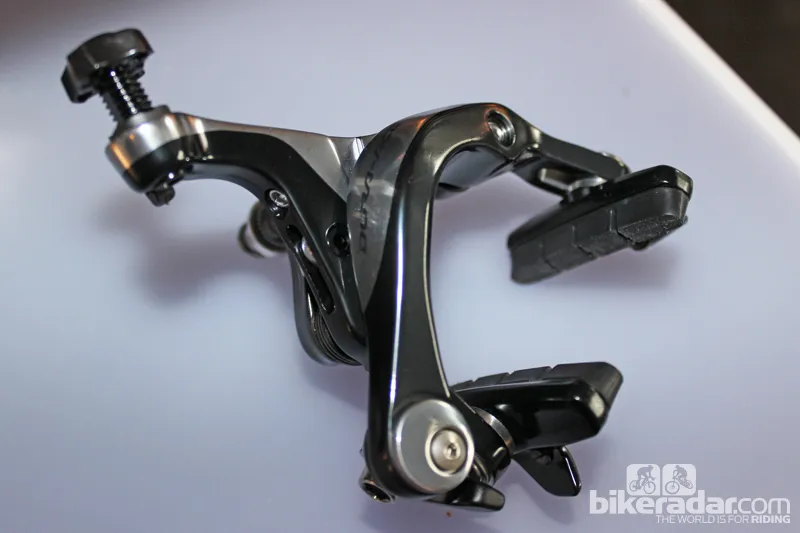
The slotted part at the bottom of the cable stop stem houses a clever roller cam to increase leverage
We spoke to Alex Dowsett of Team Sky about the braking as he’s been involved in the development of the group and has used the brakes throughout his early season racing (prior to his crash and subsequent broken elbow at the Three Days of West Flanders (Driedaagse van West-Vlaanderen) in early March. "The biggest difference is the brakes," he said. "It's allowed me to outbrake other riders leading into corners. That makes it easy to hold your position, even gain a few, and gives much more confidence too."
One chainset to rule them all
One of the most obvious visual changes is the new chainset, which has just four arms instead of the previous five. These aren't positioned symmetrically as you might expect, but instead in the optimum position to support and stiffen the chainrings where needed at the most power-intensive points of the pedal stroke. Shimano say this design reduces weight but keeps good rigidity. In fact, they claim it's “just as stiff as [Dura-Ace] 7900" despite being 52g lighter.
Shimano continue to use their innovative hollow aluminium crank arm (and outer chainring) technology for Dura-Ace – they still haven’t succumbed to carbon fibre here. The company's Tim Gerrits told us: "While Shimano have every element in place to produce the highest quality composite components – as our fishing arm produces some of the most advanced carbon fibre fishing rods available – under testing, in the real world, in mechanical and engineering terms, we’ve found our aluminium technology outperforms composites in this application. Composites have their place in plenty of parts of a bike, but for cranks, we think lightweight, highly engineered aluminium offers the best choice in terms of performance, strength and longevity."
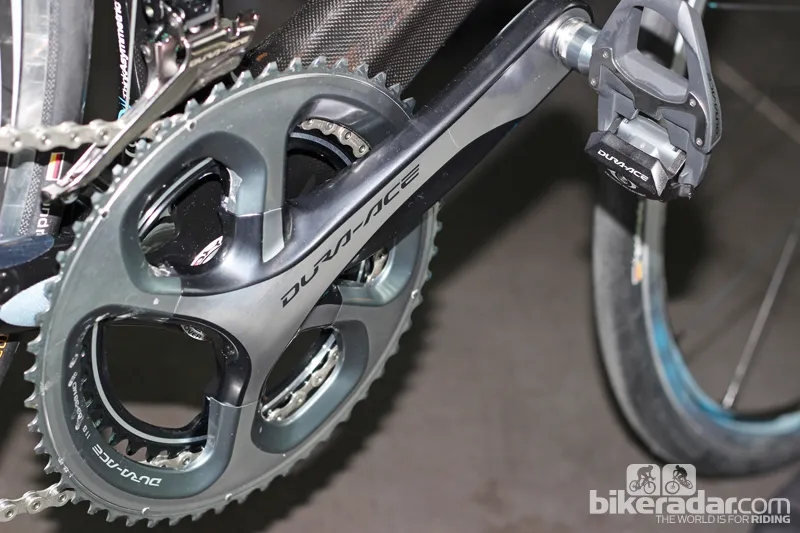
The chainset has a new four-arm design and scalloped crank arms but uses the same hollow technology for construction of both the cranks and outer chainring
Shimano have chosen to stay away from the latest oversized axle designs like BB30 and have retained a 24mm axle; they say this offers all the stiffness and strength you need so it isn’t necessary to change. What they have altered, though, is the cranks' bolt-circle diameter (BCD). Before anyone bemoans the introduction of yet another ‘standard’, we actually think this is one that should be embraced.
The new BCD – or should that be BSD (bolt-square diameter), or even BTD (bolt-trapeze diameter), given that there are only four arms? – allows the same chainset to take anything from a 34 to 42t inner chainring, and a 55 to 50t outer ring. This means you can keep your bigger gearing for use on flatter terrain but, with a simple change of rings, change to a compact setup for the mountains. This will save both money and time, and give you a bike that’s easier to tune to your expected terrain.
So, what is the BCD? Shimano wouldn't tell us, presumably because they don't want to give aftermarket manufacturers a head start. Besides saving weight, the company say their aim with the new crankset was to offer as many gearing options as possible, to suit every riding style. The result is a choice of six different chainring configurations, split into four categories: compact (50/34-tooth), standard (53/39t), sportive (52/36 or 52/38t) and time trial (54/42 or 55/42t). We’re quite excited at the prospect of a 52/36t as an ideal all-rounder.
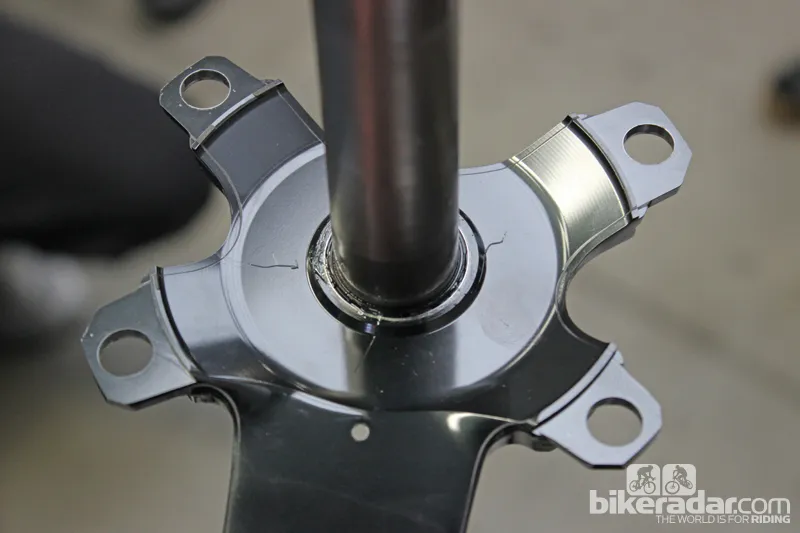
The chainset's new BCD allows it to be fitted with an outer chainring with between 50 and 56 teeth, and an inner with 34 to 55
Chain and cassette
An extra sprocket out back means a new chain. It's the same width as Shimano's 10-speed chains but has a slightly shorter pitch (the distance between the chain rivets). The sprockets are exactly the same thickness as on 10-speed Dura-Ace, just closer together. This means a wider freehub body is required (by around 1.5mm). This shouldn't cause compatibility issues with the major wheel brands as their hubs are designed to accommodate Campagnolo’s long-standing 11-speed standard. The major exception is Shimano's own wheels, which have been redesigned to accommodate the wider cassettes.
The cassette will now be available with an optional, climbing-friendly 28t smallest sprocket. There'll be five options – 11-23, 11-28, 12-28, 11-25 and 12-25t – and the extra sprocket should make for a smoother, more even gear progression. Sky’s Michael Rodgers and the mechanics at the Service Course HQ agreed that you could potentially only need one type of cassette for the whole season – a bonus for them in terms of logistics. While not as important for the rest of us, combined with the adaptability of the crankset it makes for a more user-friendly groupset.
The new CN-9000 chain is no longer directional like the outgoing version, so it can be run either way round. Shimano say the improved shifting of Dura-Ace 9000 means the previous uni-directional design no longer offers any advantages. There's also no chance of fitting the new chain the wrong way round. It uses a new PTFE plating process which, it's claimed, increases durability by 20 percent.
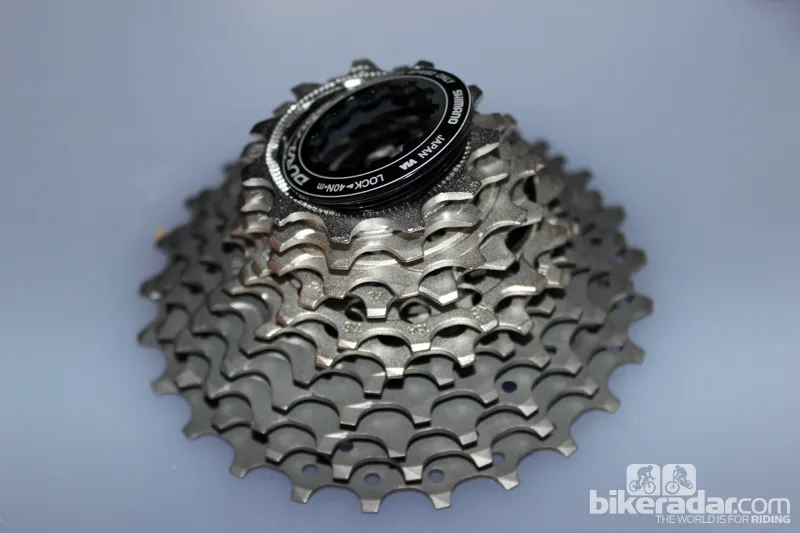
The new sprockets are the same width as 10-speed Dura-Ace’s but the cassette now incorporates one more gear
Rear derailleur
The Dura-Ace rear derailleur has been significantly lightened. Its appearance, for those who care, is more considered too – the sculpted, heavily machined main body, shorter overall dimensions and more compact cage all look great. Shimano reckon it's more robust, too.
Shimano have worked heavily on creating a more ‘equal’ operation – not only through the feel of the lever, whether shifting up or down the block, but in terms of tension. Whereas previously Dura-Ace felt as if it was being ‘released’ when dropping down into smaller cogs, the feel when riding is now a much more positive, mechanical movement.
When dropping through the cogs it feels precise and even, with little or no chatter, just slick shifts. Rising up the block takes the same amount of effort – you never get the feeling that you're pushing up through resistance to get the next gear. The light, smooth and quiet nature that recent Shimano drivetrains have been renowned for remains, but they’ve managed to add a bit of feedback, making for a gear change that’s swift but still lets you know it's happened, and precisely too.
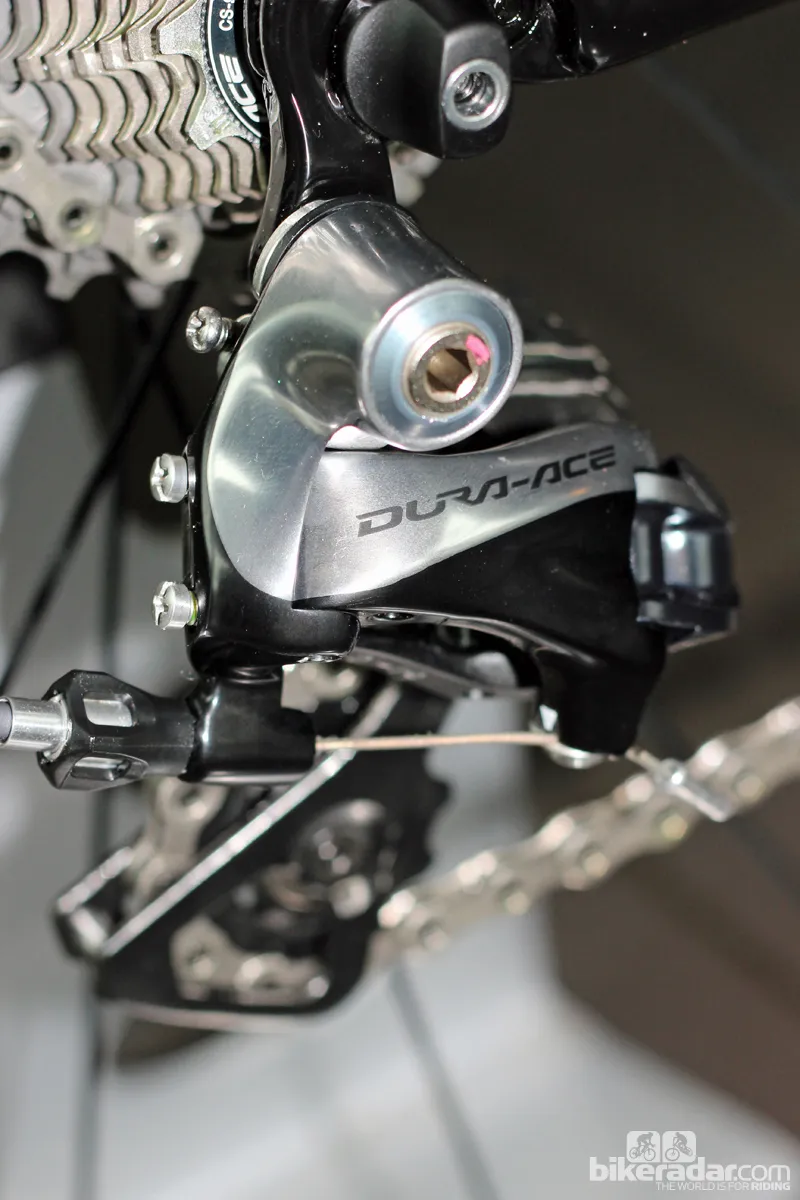
The front and rear mechs have been reduced in size and weight
All of the improvements are aided by a new cable set for both brakes and gears. The new inners have a polymer tube coating that decreases friction over the previous PTFE-plated gear cables by a claimed 10 percent.
The polymer rings which make up the tube cope better with bends and curves than a standard cable, reducing the liner's contact surface. This is ideal for the latest generation of frames with full internal cable routing, like our test ride Pinarello Dogma2s. The rings also trap lubricant. The result, according to Shimano, is that with the new shifters, derailleurs and cables fitted, front shifts require up to 43 percent less effort than with Dura-Ace 7900, and rear shifts 47 percent less effort.

The new polymer cable coating, left, compared to the previous PTFE plating
Pedal on
Shimano's carbon-bodied Dura-Ace 7900 pedals were highly rated so they've wisely decided not to mess with a successful formula and opted for a cosmetic upgrade instead for the PD-9000 model. An optional 4mm longer axle is available (56mm from inside of crank arm to centre of pedal, compared to 52mm for standard axle) – a small change but one that'll appeal to bigger riders who want a wider Q factor. This has resulted from feedback from bike-fitters and bio-mechanic data from the pro teams.
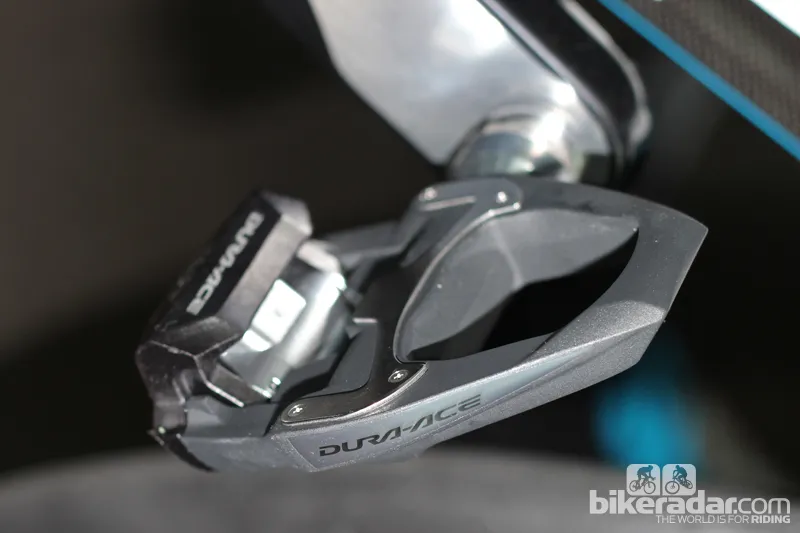
The Dura-Ace pedals now have an optional longer axle and reduced-float cleat
There's also a new blue cleat (SM-SH12) which Shimano describe as a “good compromise for people who need a bit of float but don’t want the shoe to move around on the pedal too much”. It pivots at the front, rather than in the centre, and offers 1° of float, compared to 3° for the standard SH11 cleat. A fixed cleat will still be available, too.
Wheels
To go with the new Dura-Ace, Shimano have a new range of 11-speed road wheels. These use a 1.85mm wider freehub than the company's 10-speed offerings in order to fit the new 11-speed cassettes. Shimano say their 11-speed cassettes can only be used with 11-speed wheels but their 11-speed wheels can be used with smaller cassettes if you fit a spacer. There are six new 11-speed wheels: C24, C35, C50 and C75 Dura-Ace models, plus two mid-range options, RS61 and RS21.
Shimano’s aim with the Dura-Ace wheels was to reduce weight compared to the previous generation, increase stiffness, improve aerodynamics and boost stability in crosswinds. That’s led to an increase in rim width to 24mm over the previous 21mm. The rear wheels have been redesigned to accommodate the wider freehub and a wider flange has been introduced to increase strength, and each wheel is optimally balanced.
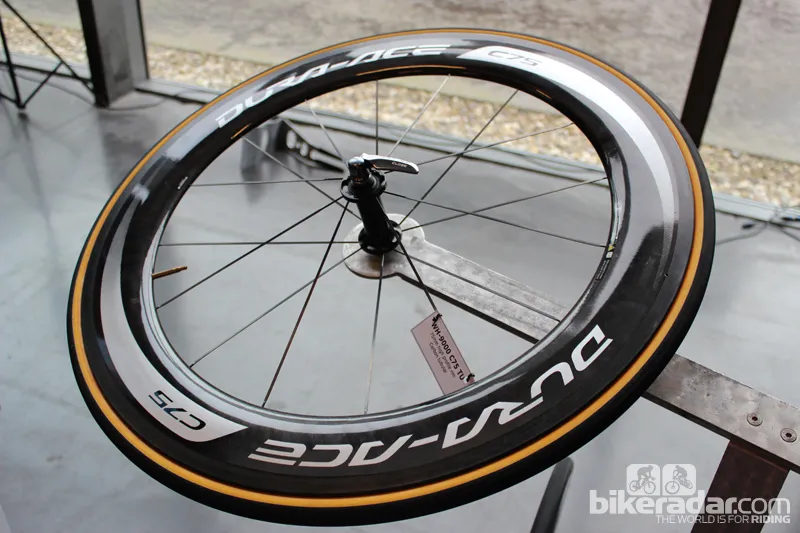
Shimano claim their revamped Dura-Ace wheels have improved aero performance, more control in sidewinds and are stiffer and stronger than ever
The deeper section wheels – C50 and C75 – have a new, wind tunnel designed 'Blade' shape (it look more like a bullet to us) that's similar to the wider rim shapes we've seen from the likes of Zipp, 3T and HED. It's rounder than the previous generation Dura-Ace 7900 C50 rim but doesn't bulge in the centre like some rival designs, as Shimano reckon this increases drag at the rear of the rim. Shimano have worked on smoothing the transition between the brake surface, rim and tyre sidewall to aid aero performance.
Not much more information was available at the launch, and no test wheels were available. They certainly look to be an improvement over the previous wheels, and looking at Team Sky’s impressive results so far this season, they seem to be proving themselves in the competitive world of the pro peloton too.
The C35s are available in clincher (carbon/alloy, 1,525g per set) and tubular (full-carbon, 1,260g) form, while the C24s come in clincher (carbon/alloy, 1,375g) and Road Tubeless (carbon/alloy, 1,455g) versions. The C75s are tubular only (full-carbon, 1,546g), while the C50s are available in clincher (carbon/alloy, 1,685g) and tubular (full-carbon, 1,425g) form.
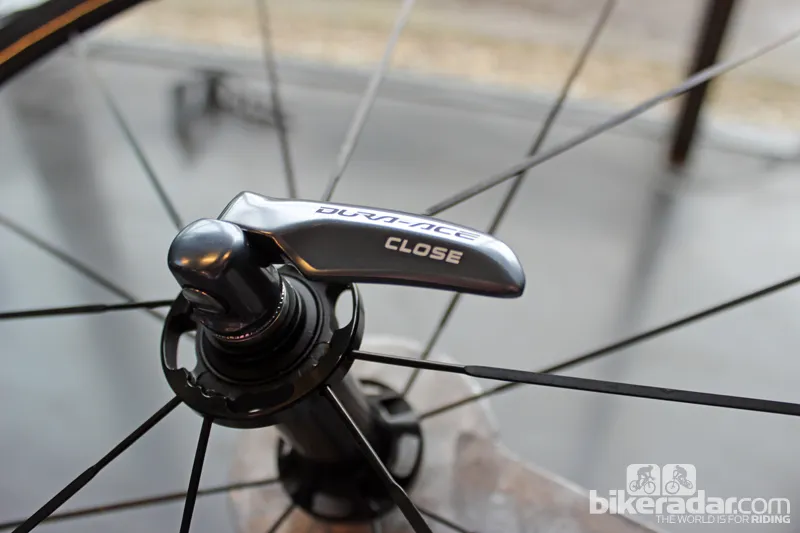
Even the quick-release skewers have received an aero makeover
Finally, the RS61 is an 11-speed Road Tubeless wheelset aimed at Ultegra level riders, while the RS21 shares a similar design but isn't tubeless compatible and is intended more as a training wheel.
First ride impressions
Overall, the new 9000 series is a vast improvement on its predecessor. The shifting is as slick and smooth as we’ve come to expect from Shimano, but they’ve looked back to the most successful version of their flagship mechanical group and emulated what made that so good – the feel and the positive, accurate shifts that gave you plenty of feedback. The result is a massively user friendly experience.
The all-new dual-pivot brake may look back to the old-school U-brake for inspiration, but the feel, massive range of modulation and confidence it gives, especially from the hoods, is one of the standout features of the new group. When mechanical rim brakes are this good, you can't help but be sceptical about the need for road disc brakes.
The new BCD standard of the chainset, which allows for both compact and standard gearing, is a simple but brilliant idea. Anything that allows you to switch between mountain range gearing and a setup suited to flatter terrain without too much expense, never mind hassle, is more than okay with us.
With the 9000 series, Shimano have returned Dura-Ace to its rightful place at the top of the tree. The only flaw in their grand plan? Well that’ll be the truly exciting things happening with its 9070 Di2 electronic cousin, which is likely to steal its thunder all too soon.
Claimed Weights - (provided by Shimano)
DURA-ACE WEIGHTS (all weights are in grams) DURA-ACE 9000 Crankset (FC-9000) : 683 Front & rear brake (BR-9000) : 297 Cassette sprockets (CS-9000) : 166 Chain (CN-9000) : 243 Rear derailleur (RD-9000) : 158 Front derailleur (FD-9000) : 66 Left & right dual control lever (ST-9000) : 365 Total weight : 1.978 Total weight with cables : 2.072 DURA-ACE 9070 Di2 Crankset (FC-9000) : 683 Front & rear brake (BR-9000) : 297 Cassette sprockets (CS-9000) : 166 Chain (CN-9000) : 243 Rear derailleur (RD-9070) : 217 Front derailleur (FD-9070) : 114 Left & right dual control lever (ST-9070) : 237 Total weight : 1.957 Total weight with wiring and internal battery (SM-BTR2) : 2.047 DURA-ACE WHEELSET WH-9000-C24-tubeless : F:630 R:824 WH-9000-C24-clincher : F:680 R:794 WH-9000-C35-tubular : F:647 R:715 WH-9000-C35-clincher : F:662 R:826 WH-9000-C50-tubular : F:641 R:808 WH-9000-C50-clincher : F:752 R:920 WH-9000-C75-tubular : F:678 R:867 HUBS Front hub (HB-9000) : 120 Rear freehub (FH-9000) : 246
